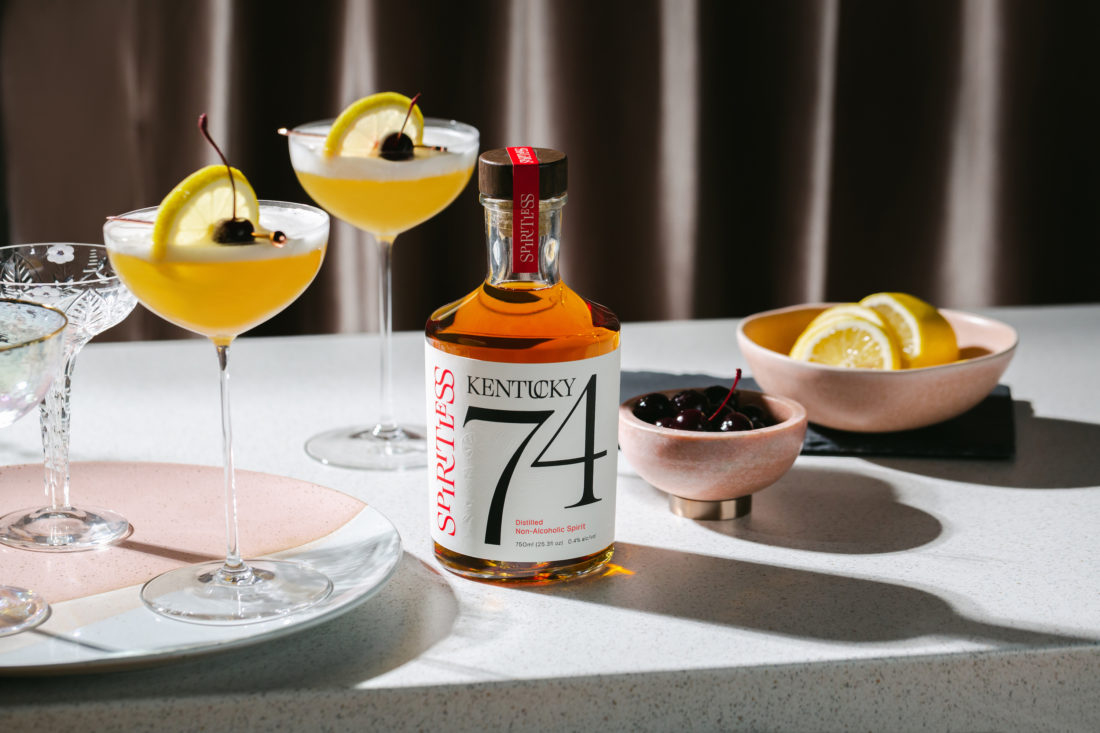The story of Spiritless Kentucky 74 bourbon is not one of burbling mash, rustic rickhouses, and hirsute master distillers. Hell, it’s not even a story of an actual bourbon. Get past all that, however, and you encounter an intriguing entry into the growing non-alcoholic spirits category.
This new faux whiskey is the creation of three cocktail-loving Louisville women: Lauren Chitwood, Abbey Ferguson, and Lexie Lancaster Larsen. Their hospitality-career outings often entail a libation or four, and after finding that such evenings were grating against early morning commitments, inspiration struck. But why tackle a non-alcoholic version of something as beloved, and hotly scrutinized, as bourbon?

“Bourbon is steeped in heritage,” Larsen says. “It’s America’s spirit. It’s also a big part of who we are.” And, says Chitwood, “Aside from bourbon being in our DNA, we saw it as an opportunity and the biggest problem to solve well.”
That endeavor started on the ground floor—actually one floor below that, in Larsen’s basement, with a mini pot still banged together from a popcorn tin and PVC pipe. Plenty of R&D (research and drinking) led to radical choices: First, a neutral grain spirit is cooked with charred oak at high temperature and infused with other flavorings and sweeteners to achieve a bourbon-ish profile. And unlike many other mock liquors, Kentucky 74 is actually distilled, but with an extra step that removes all but trace amounts of alcohol. (A grain list that doesn’t include at least 51 percent corn disqualifies it as bourbon, not the absence of alcohol.) “Distilling allows us to hold onto the tannins and oils,” Chitwood says. “What we’ve accomplished is the mouthfeel of bourbon.”
Industry pros haven’t necessarily encouraged such heresy. “The kings of bourbon couldn’t separate themselves from tradition enough to understand why we were even doing this,” Larsen says. Adds Chitwood, “There also may have been a bit of mansplaining going on.”
Undaunted, the trio smuggled a prototype batch into a food-and-wine fest and garnered positive feedback from the tastemakers they cornered with samples. After becoming Kentucky’s seventy-fourth licensed distillery and scaling up the operation, there was no turning back.

So how does Kentucky 74 taste? An initial sniff and sip reveal for sure that it’s not real-deal bourbon, if only because it lacks the alcohol “burn” universal to whiskey. But the foundations of bourbon flavor—oak, vanilla, caramel—are there, lending credence to its creators’ contention that it’s primarily a cocktail component. Indeed, when combined with the other ingredients of an old fashioned, flavor variance is greatly diminished. “It also blends beautifully with alcoholic bourbon to reduce the overall alcohol level,” Chitwood says. “Even that choice makes it easier to get up for a 9 a.m. meeting.”
The trio estimates that female imbibers such as themselves might be most inclined to give Kentucky 74 a try. That said, they aren’t writing off entirely the male consumer, who might not “be sipping Kentucky 74 neat,” Ferguson says. “But in a cocktail, we think he might.”









